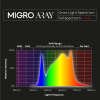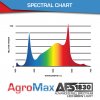KorayChiefEngineer
New Member
The spectral advantages of global brand LED plant lights
Modern agriculture is increasingly using LED plant lights, whether it is outdoor planting supplement light or LED plant lights for indoor planting, the spectrum of plant lights is very important. A good plant light spectrum can increase the output by more than 20% , Special purpose plant light spectrum can improve the quality of planted products, such as improving micro-green vegetables such as: perilla, sugar beet, basil and Chinese cabbage to increase yield, increase anthocyanin content, enhance flavor and taste, and improve plants Shape and color. It can also increase the content of compounds, such as THC, CBD, terpenes, flavonoids, etc.
Is there the best LED plant light spectrum? I will not list it here for the time being. Let’s take a look at the plant light spectrum of the world’s well-known LED plant light manufacturers. Can you identify which brand of product the spectrum is in the picture below?


The spectra of several mainstream brands are listed above. Follow their instructions for the role and use of spectra:
Among them, the most used growth stages for cannabis cultivation, nutrition, flowering, and blooming: including, spectrum 1, spectrum 3, spectrum 4, spectrum 5, spectrum 6, spectrum 7, spectrum 9, and spectrum 10.
Among them, Spectrum 2 and Spectrum 4 are very close, but the scenarios used by the two brands are different.
Spectrum 7, spectrum 6, and spectrum 5 are relatively close, and they are all used in the flowering period of cannabis cultivation.
Spectrum 11 for the seedling stage
Spectrum 13 is used to fill light in the greenhouse. This spectrum can achieve very high light efficiency, Its efficiency can exceed 3.5umol/J
Spectrum 12 is a more widely used full spectrum, suitable for most plants, but this spectrum has relatively low light efficiency.
Spectrum 8 is also a high-efficiency spectrum with high color rendering and high efficiency, which is friendly to humans and plants.
I personally think that the color rendering index is high, and at the same time there are fewer green photons, which is a relatively good spectrum. Spectra No. 3 and No. 9 have less green light factor and will be more energy-efficient, and they also have a high color rendering index, Ra >90 is a spectrum that is friendly to the human body and can provide a work environment with high color recognition.
What is the best spectrum? It can only be said that the above spectra have their own advantages.
If you must choose the best spectrum, I vote for the No. 14 spectrum, which consists of 4 independent channels. All 4 channels are turned on with 100% brightness, and the combination is close to the No. 3 spectrum; I personally think that a good spectrum Should be divided into multiple channels, the spectrum that can be adjusted, we can adjust the spectrum according to different application scenarios, and adjust to the appropriate spectrum in different growth periods. Of course, this requires that we also know the spectrum and know what kind of light the plants we grow need.
Fortunately, in the field of plant illumination, the spectral effects of each wavelength are increasingly discovered and confirmed. Or, in the application of multi-channel spectrum adjustable LED plant lights, your theory will also be confirmed!
Finally, can you guess what brand of LED plant light the above spectrum is?
Among the brands are: Fluence, Gavita, Valoya, SAMSUNG, lumigrow, Lumatek, etc.
For specific answers, please leave a message to me.
Modern agriculture is increasingly using LED plant lights, whether it is outdoor planting supplement light or LED plant lights for indoor planting, the spectrum of plant lights is very important. A good plant light spectrum can increase the output by more than 20% , Special purpose plant light spectrum can improve the quality of planted products, such as improving micro-green vegetables such as: perilla, sugar beet, basil and Chinese cabbage to increase yield, increase anthocyanin content, enhance flavor and taste, and improve plants Shape and color. It can also increase the content of compounds, such as THC, CBD, terpenes, flavonoids, etc.
Is there the best LED plant light spectrum? I will not list it here for the time being. Let’s take a look at the plant light spectrum of the world’s well-known LED plant light manufacturers. Can you identify which brand of product the spectrum is in the picture below?


The spectra of several mainstream brands are listed above. Follow their instructions for the role and use of spectra:
Among them, the most used growth stages for cannabis cultivation, nutrition, flowering, and blooming: including, spectrum 1, spectrum 3, spectrum 4, spectrum 5, spectrum 6, spectrum 7, spectrum 9, and spectrum 10.
Among them, Spectrum 2 and Spectrum 4 are very close, but the scenarios used by the two brands are different.
Spectrum 7, spectrum 6, and spectrum 5 are relatively close, and they are all used in the flowering period of cannabis cultivation.
Spectrum 11 for the seedling stage
Spectrum 13 is used to fill light in the greenhouse. This spectrum can achieve very high light efficiency, Its efficiency can exceed 3.5umol/J
Spectrum 12 is a more widely used full spectrum, suitable for most plants, but this spectrum has relatively low light efficiency.
Spectrum 8 is also a high-efficiency spectrum with high color rendering and high efficiency, which is friendly to humans and plants.
I personally think that the color rendering index is high, and at the same time there are fewer green photons, which is a relatively good spectrum. Spectra No. 3 and No. 9 have less green light factor and will be more energy-efficient, and they also have a high color rendering index, Ra >90 is a spectrum that is friendly to the human body and can provide a work environment with high color recognition.
What is the best spectrum? It can only be said that the above spectra have their own advantages.
If you must choose the best spectrum, I vote for the No. 14 spectrum, which consists of 4 independent channels. All 4 channels are turned on with 100% brightness, and the combination is close to the No. 3 spectrum; I personally think that a good spectrum Should be divided into multiple channels, the spectrum that can be adjusted, we can adjust the spectrum according to different application scenarios, and adjust to the appropriate spectrum in different growth periods. Of course, this requires that we also know the spectrum and know what kind of light the plants we grow need.
Fortunately, in the field of plant illumination, the spectral effects of each wavelength are increasingly discovered and confirmed. Or, in the application of multi-channel spectrum adjustable LED plant lights, your theory will also be confirmed!
Finally, can you guess what brand of LED plant light the above spectrum is?
Among the brands are: Fluence, Gavita, Valoya, SAMSUNG, lumigrow, Lumatek, etc.
For specific answers, please leave a message to me.


















